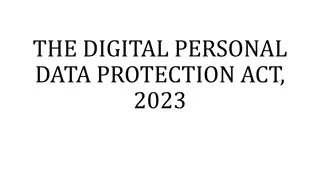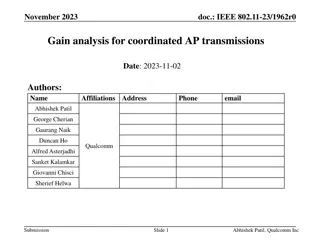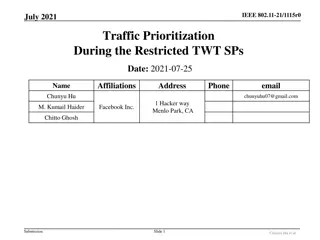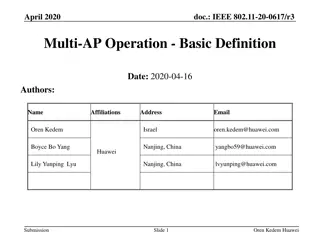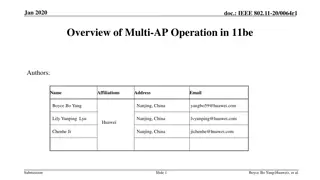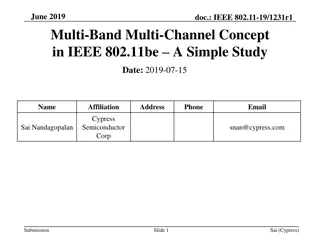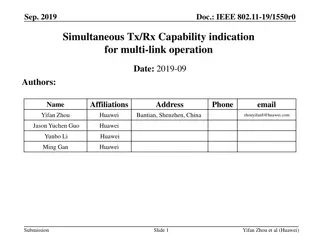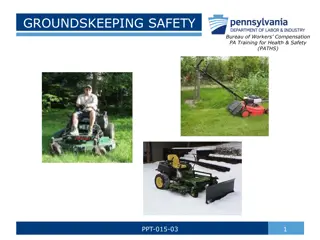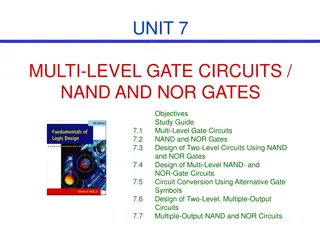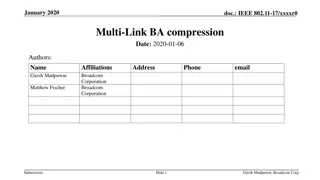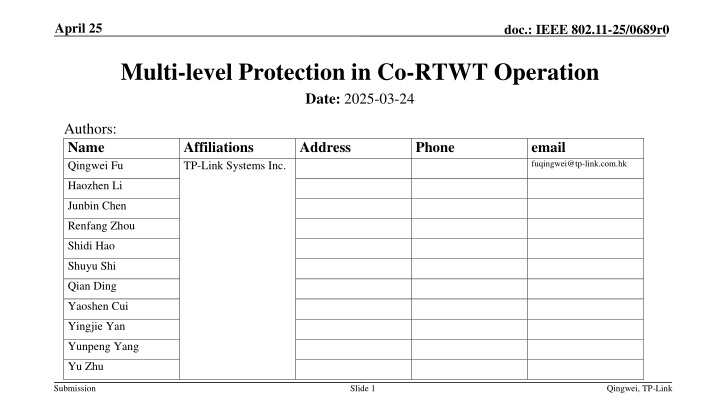
Multi-level Protection in IEEE 802.11 Co-RTWT Operations
Explore the mechanisms for multi-level protection in Coordinated Restricted Target Wake Time (Co-RTWT) operations as defined in the IEEE P802.11 standard. Discuss considerations, access policies, and progress made by TGbn in Co-RTWT coordination. Learn about the challenges, negotiation mechanisms, and network efficiency issues related to Co-RTWT operations.
Download Presentation

Please find below an Image/Link to download the presentation.
The content on the website is provided AS IS for your information and personal use only. It may not be sold, licensed, or shared on other websites without obtaining consent from the author. If you encounter any issues during the download, it is possible that the publisher has removed the file from their server.
You are allowed to download the files provided on this website for personal or commercial use, subject to the condition that they are used lawfully. All files are the property of their respective owners.
The content on the website is provided AS IS for your information and personal use only. It may not be sold, licensed, or shared on other websites without obtaining consent from the author.
E N D
Presentation Transcript
April 25 doc.: IEEE 802.11-25/0689r0 Multi-level Protection in Co-RTWT Operation Date: 2025-03-24 Authors: Name Qingwei Fu Affiliations TP-Link Systems Inc. Address Phone email fuqingwei@tp-link.com.hk Haozhen Li Junbin Chen Renfang Zhou Shidi Hao Shuyu Shi Qian Ding Yaoshen Cui Yingjie Yan Yunpeng Yang Yu Zhu Submission Slide 1 Qingwei, TP-Link
February 25 doc.: IEEE 802.11-25/0689r0 Abstract IEEE P802.11bn D0.2 has defined coordinated restricted target wake time (Co- RTWT) operations in the Multi-AP coordination framework[1] In this contribution, we discuss the multi-level protection mechanisms in Co- RTWT operation Submission Slide 2 Qingwei, TP-Link
February 25 doc.: IEEE 802.11-25/0689r0 Recap TGbn has made progress on Co-RTWT with following motions passed. [Motion #48, [2]] Define mechanisms that enable APs to coordinate their rTWT schedule(s) and/or to ensure that one AP provides the protection of the rTWT schedule(s) of the other AP. NOTE TBD mechanisms including negotiation between 2 APs and advertisement. [Motion #149, [2]] If an AP extends the protection of the rTWT schedule of another AP, following negotiation or through other means, then: The AP shall ensure its TXOP ends before the start time of the corresponding OBSS rTWT SP(s) The AP, if it has at least one associated STA that is capable of rTWT, shall advertise in the beacon frames it transmits the OBSS rTWT schedule so that its associated STAs supporting rTWT follow the baseline rTWT rules for the OBSS rTWT schedule. [Motion #362, [2] ] A Co-RTWT Requesting AP shall include one or more Co-RTWT Parameter Set fields corresponding to each requested R-TWT schedule in the TBD individually addressed Management frame used for the request to the Co-RTWT Responding AP. The Co-RTWT Parameter Set field includes the following: Target Broadcast TWT ID field Broadcast TWT Persistence TWT Wake Interval Mantissa TWT Wake Interval Exponent Nominal Minimum TWT Wake Duration TBD other fields Wake Time field Submission Slide 3 Qingwei, TP-Link
February 25 doc.: IEEE 802.11-25/0689r0 Medium Access during Co-RTWT SP in 11bn Some Channel access policies in previous contributions: 1. Ending TXOP before the Co-RTWT SP start time[3-4] Responding AP shall ensure that its TXOP ends before the start time of the SP 2. Access to channel by negotiating Co-TDMA or Co-SR or Co-BF [5] Responding AP may piggyback Co-TDMA/Co-SR/Co-BF information in the Co-RTWT negotiation and access to channel by Co-TDMA or Co-SR or Co-BF mechanism 3. Access to channel by R-TWT sharing [6] Responding AP access to channel by requesting AP to share the TXOP obtained during the R-TWT SP Submission Slide 4 Qingwei, TP-Link
February 25 doc.: IEEE 802.11-25/0689r0 Considerations in Co-RTWT SP Overprotection/ Network efficiency Issues The requesting AP may not leverage the SP, which reduces the whole network efficiency, while the responding AP (OBSS) provides the protection for the whole SP duration Co-RTWT SP Requesting AP TX/RX Idle (Overprotected) Responding AP Access forbidden Overlapped SP issues The Co-RTWT coordination negotiation may be failed due to the overlapped RTWT SP in OBSS BSS-1 RTWT SP in BSS-1 Co-RTWT SP protection Negotiation Failing BSS-2 RTWT SP in BSS-2 Submission Slide 5 Qingwei, TP-Link
February 25 doc.: IEEE 802.11-25/0689r0 Proposal: Multi-level Protection in Co-RTWT OBSS APs negotiate Multi-level protection for the Co-RTWT SP Level 1: Robust protection (eg, non-overlapped RTWT SP) Responding AP and its associated STAs shall not access to the channel during the Co-RTWT SP Responding AP may switch into Power Saving state for higher power efficiency Level 2: MAP coordinated transmission (MAPCT) protection (eg, overlapped RTWT SP) The channel access in controlled by the requesting AP Responding AP may access to the channel by Co-TDMA, Co-BF and Co-SR Level 3: Other protection Eg., Responding AP may access to channel by negotiating a non-overlapped NPCA primary channel Co-RTWT coordination negotiation procedure Protection level request Requesting AP Protection level response Responding AP Submission Slide 6 Qingwei, TP-Link
February 25 doc.: IEEE 802.11-25/0689r0 Examples When Robust protection negotiated, the power efficiency can be improved in responding AP Co-RTWT SP TX/RX Requesting AP Robust protection Request AP Power Save Responding AP Robust protection Response When MAPCT protection negotiated, the OBSS network efficiency can be improved Co-RTWT SP TX/RX Requesting AP MAPCT protection Request TX/RX Responding AP MAPCT protection Response Submission Slide 7 Qingwei, TP-Link
February 25 doc.: IEEE 802.11-25/0689r0 Summary In this contribution, we propose a multi-level protection mechanism in Co- RTWT operation that throw a potential method to leverage the channel resource and improve the efficiency in the MAP OBSS system. Multi-level protection may include 1. Robust protection 2. MAP coordinated transmission protection (details are TBD) 3. Others protection (eg, Co-RTWT based NPCA primary channel negotiation ) Submission Slide 8 Qingwei, TP-Link
February 25 doc.: IEEE 802.11-25/0689r0 Straw Poll 1 Do you agree to add the following text to the TGbn SFD? Define a multi-level protection mechanism for Co-RTWT coordination negotiation Multi-level protection may indicates either; Robust protection MAP coordinated transmission protection (details are TBD) Others protection is TBD (eg, Co-RTWT based NPCA primary channel negotiation ) Submission Slide 9 Qingwei, TP-Link
February 25 doc.: IEEE 802.11-25/0689r0 References [1] IEEE P802.11bn D0.2 [2] 11-24/0209r13, Specification Framework for TGbn [2] 11-23/0226r3, Coordination of R-TWT for Multi-AP Deployment [3] 11-24/0678r2, Coordinated R-TWT Follow Up [4] 11-25/0011r0, Co-RTWT Follow Up [5] 11-25/0289r2, R-TWT Sharing Follow-Up Submission Slide 10 Qingwei, TP-Link

